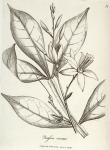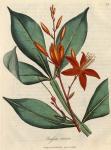
 Also see 076. Quassia Simaruba. Simaruba quassia.
Also see 076. Quassia Simaruba. Simaruba quassia.
Synonyma. Quassia. Pharm. Lond. & Edinb.
Quassia pentapbylla pediculis alatis, floribus racemosis terminalibus coccineis fructu pentaspermo. Patris in Gazette salutaire, 1777, n. 41. 42. item in Rozier Observations sur la Physique. Tom, ix. 1777. p. 140. Supp. Plant. p. 235.
Class Decandria. Ord. Monogynia. Lin. Gen. Plant. 529.
Ess. Gen. Ch. Cal. 5-phyllus. Petala 5. Nectarium 5-phyllum. Pericarpia 5, distantia 1-sperma.
Spec. Char. Q. floribus hermaphroditis, foliis impari-pinnatis, foliolis oppositis sessilibus, petiolo articulato alato, floribus racemosis. Suppl. Plant.
This tree rises several feet in height, and sends off many strong branches: the wood is white and light; the bark is thin, and of a grey colour: the leaves are placed alternately upon the branches, and consist of two pair of opposite pinnae, with an odd one at the end: all the leafets are of an elliptical shape, entire, veined, smooth, pointed, sessile, on the upper pagina of a deep green colour, on the under paler: the common footstalk is articulated and winged, or edged, on each side with a leafy membrane, which gradually expands towards the base of the pinnae: the flowers are all hermaphrodite, of a bright red colour, and terminate the branches in long spikes: the bracteae or floral leaves are lance-shaped or linear, coloured, and placed alternately upon the peduncles: the calyx is small, persistent, and five-toothed: the corolla consists of five lance-shaped equal petals, at the base of which is placed the nectary, or five roundish, coloured, scales: the filaments are ten, slender, somewhat longer than the corolla, and crowned with simple antherae, placed transversely: the receptacle is fleshy and orbicular: the germen is ovate, divided into five parts, and supports a slender style, longer than the filaments, and terminated by a tapering stigma: the capsules are five, two-celled, and contain globular seeds. It is a native of South America, particularly of Surinam, and also of some of the West-India islands.
The botanical character of this species of Quassia was known long before that of the Simaruba, as it is noticed in its proper place in the Sp. Plantarum, upon the authority of Dahlberg, when it was thought peculiar to Surinam; afterwards, Linnaeus, in his Materia Medica, referred it to the Nux americana, foliis alatis bifidis of Commelin. [Hort. i. p. 423. t. 94.] It appears, however, that the figure given in the Amoenitates Academicae, [See Vol. vi. p. 416.] is not a faithful representation of this species; hence the younger Linnaeus has observed, "Figura floris in Dissertatione Parentis de Quassia vera est, sed ramulus cum foliis ad aliam pertinet;" [Suppl. Plant. p. 235.] and consequently those copied from it, and since published by Buchoz, and others, are with respect to the leaves erroneous; [On this account, we have not referred to the figure of the Quassia, lately published by Dr. Lettsom in the Mini, of the Med. Society.] this will be evident, upon consulting the plate and description of the Quassia given by Patris, as well as the Icon here annexed, which was drawn from a specimen in the possession of that able naturalist Dr. J. E. Smith, President of the Linnaean Society. [The ample and valuable collection of specimens in Natural History made by Linnaeus, and to which most of his contemporary naturalists were contributors, are now in the possession of this Gentleman, who has obligingly offered us any assistance it may afford us in the prosecution of this work.]
The root, bark, and wood [It may also be remarked, that the leaves, flowers, &c. likewise possess similar qualities. Toutes les parties du Cassie, écorce, bois, feuilles, fleurs, calice, enveloppes des graines, et les graines memes, sont d'une amertume energique, et dont n'approche aucun medicament jusqu'a present connu, &c. Patris l. c. p. 144.] of this tree, are all comprehended in the catalogues of the Materia Medica; but as the roots are perfectly ligneous, they may be medically considered in the same light as the wood, which is now most generally employed, and seems to differ from the bark in being less intensely bitter; the latter is therefore thought to be a more powerful medicine. Quassia has no sensible odour; its taste is that of a pure bitter, more intense and durable than that of almost any other known substance; it imparts its virtues more completely to watery than to spirituous menstrua, and its infusions are not blackened by the addition of martial vitriol. The watery extract is from a sixth to a ninth of the weight of the wood; the spirituous about a twenty-fourth. Quassia derived its name from a negro named Quaffi, (by Fermin [Description de la Colonie de Surinam. Tom. i. p. 212.] written Coissi, and by Rolander Quass) who employed it with uncommon success, as a secret remedy in the malignant endemic fevers, which frequently prevailed at Surinam. In consequence of a valuable consideration, this secret was disclosed to Daniel Rolander, a Swede, who brought Specimens of the Quassia-wood to Stockholm, in the year 1756; and since then the effects of this drug have been very generally tried in Europe, and numerous testimonies of its efficacy published by many respectable authors. [Of these we may mention Linnaus, Dahlberg, Blom, Fermin, Tissot, Thorstensen, Severius, Ebeling, Patris, and many others, for which see Murray App. Med. vol. iii. p. 432. & seq.] Various experiments with Quassia have likewise been made, with a view to ascertain its antiseptic powers, from which it appears to have considerable influence in retarding the tendency to putrefaction, [Vide Ebeling Diss. de Quassia, &c. p. 14. Severius, Comment. in quo medicata Quassia vires expenduntur. p. 77.] and this Professor Murray thinks cannot be attributed to its sensible qualities, as it possesses no astringency whatever, nor can it depend upon its bitterness, as gentian is much bitterer, yet less antiseptic. The medicinal virtues ascribed to Quassia are those of a tonic, stomachic, antiseptic, and febrifuge; it has been found very effectual in restoring the tone of the stomach, producing appetite for food, assisting digestion, expelling flatulency, and removing habitual costiveness, produced from debility of the intestines, and common to a sedentary life. Dr. Lettsom, whose extensive practice gave him an opportunity of trying the effects of Quassia in a great number of cases, says, "In debility, succeeding febrile diseases, the peruvian bark is most generally more tonic and salutary than any other vegetable hitherto known; but in hysterical atony, to which the female sex is so prone, the Quassia affords more vigour and relief to the system than the other, especially when united with the vitriolum album, and still more with the aid of some absorbent." In dyspepsia, arising from hard drinking, and also in diarrhoeas, the Doctor exhibited the Quassia with great success. But with respect to the tonic and febrifuge qualities of Quassia, he says, "I by no means subscribe to the Linnaean opinion, where the author declares, me quidem judice chinchinam longe superat: it is very well known, that there are certain peculiarities of the air and idiosyncrases of constitution, unfavourable to the exhibition of the peruvian bark, even in the most clear intermissions of fever, and writers have repeatedly noticed it; but this is comparatively very rare. About midsummer, 1785, I met with several instances of low remittent and nervous fevers, wherein the bark uniformly aggravated the symptoms, though given in intermissions the most favourable to its success; and wherein Quassia, or snake-root, was successfully substituted. In such cases, I mostly observed, that there was great congestion in the hepatic system, and the debility at the same time, discouraged copious evacuations."—And in many fevers without evident remissions to warrant the use of the bark, whilst at the same time increasing debility began to threaten the life of the patient, the Doctor found that Quassia, or snake-root, singly or combined, "upheld the vital powers, and promoted a critical intermission of fever," by which an opportunity was offered for the bark to effect a cure. [See Memoirs of the Med. Society, vol. i. p. 150. Dr. Cullen says, "I believe Quassia to be an excellent bitter, and that it will do all that any pure and simple bitter can do; but our experience of it in this country does not lead us to think it will do more; and the extraordinary commendations given of it are to be ascribed to the partiality so often shewn to new medicines. Mat. Med. v. ii.p. 74.] It may be given in infusion, or in pills made from the watery extract, the former is generally preferred in the proportion of three or four drams of the wood to twelve ounces of water.

